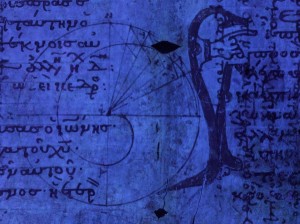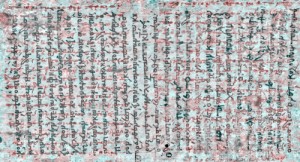Archimedes spiral imaged in UV rays, from the Archimedes Palimpsest, via scientificamerican.com
Dear Naya,
What is it about palimpsests that moves and fascinates people?
Perhaps that a palimpsest is a triumph of survival against the odds: the scratched-out words underneath have beaten not just time and decay, but have overcome the deliberate attempt to obliterate them. Despite the slow scholarliness of the act, there is still an aggression in their making, and a tension between the two scribes across time, strangers but intimately opposed. More than this, to decipher a palimpsest is to crack an archaeological riddle. Some are made from codices whose pages have been sliced up and turned around and re-ordered into the new codex, so that the researchers’ first step is to undo and re-assemble them like a jigsaw puzzle.
After this, there comes the task of trying to unveil the overwritten text. When, after centuries hidden in monastery libraries, these documents are taken out again, sometimes the simple action of common air can be enough to revive the ink behind – so that the original text naturally asserts itself and penetrates the overlying writing. But not always – and so palaeographers in the nineteenth century tried out various methods involving noxious chemicals such as tincture of gall, a crude approach that could ruin the precious document. Since then, progressively less intrusive methods like ultraviolet light, multispectralfilm and X-ray fluorescence imaging have evolved to keep the delicate vellum and layers of ink intact while allowing the revelation of the text, itself often encrypted in an ancient, half-forgotten language or script.
Precisely because it represents such a strong image of enigmatic layering in our minds, the term palimpsest has spread to a diverse array of areas. In forensic science, for instance, it means that objects are placed over one another in order to work out the order of events at a crime scene. Elsewhere it can describe the augmented realities created by the melding of layers of material places and their virtual representations. Glaciology, architecture, astronomy, medicine and design all have their own palimpsests.
In history, it is used as a term to indicate the way people recall different events within and beyond their lifetimes – as a layering of experiences over faded pasts. Some memories remain fresh and are kept alive, while some memories recede, some that are inconvenient or even painful are deliberately buried and overwritten. Just as with a real palimpsest, these memories can resurface naturally later, triggered by exposure to private or collective resonances. They can be directly confronted by the practice of intervention and recollection, brought to the surface over-abruptly. Or they can be revealed and reflected in a complex artistic process that does not interfere with the integrity of the material.
Dear Kate,
Some time ago I heard that remembering is a much more psychotic activity than forgetting. Certainly in the process of recalling there is two possible results: one is obtaining an image of a fact that happen in the past; the other one, is to revive something that have never been lived. For me memory, as palimpsest, is a narrative proposal that mixes reality and fiction. In the case of the palimpsest, the writing and over-writing produces a new constellation that translates in a new text. In the case of memory and recalling it seems to be a combination of false statements and truth. After all, most of the time, humans lye to themselves in order to keep their head in position, thus when there is time for remembrance the activated information appears double, with what happened and what didn’t. As in a palimpsestic surfaces, in memory, there is a big floating ghost that resembles something that never existed. Both, memory and palimpsest, are then, nothing more that different methodologies of narration.

